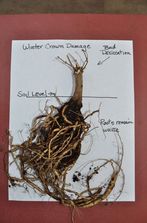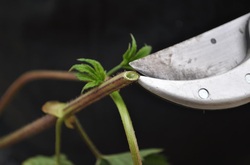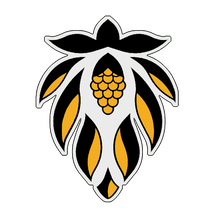|
I am busy doing field checks with hop growers during the month of May. I am finding winter crown desiccation in new hop yards that did not have reliable snow cover. The crowns appear to have been exposed to sun & wind while the ground was frozen. The fleshy roots remain white - no rot is present. The frozen soil/roots could not supply water to the exposed crown as it is dried out by the sun & wind. There have been no reports of this type of winter damage from up North, where they had good snow cover. Varieties like Zeus, Glacier, Saazer, Nugget & Cascade were affected more than varieties like Chinook. Protecting these crown buds from exposure is important ! Some of these damaged crowns may regenerate slowly; given time. Our winter exposures and duration are longer and harsher in the Midwest than those out in Oregon and Washington.  Click to enlarge Click to enlarge Crown buds can be protected in several ways as you prepare you hop yard for winter. First, leave the hop bines cut at 24 to 36 inches high over the winter. The old bines supply extra sugars to the crowns and act like little snow fences; slowing the wind, holding snow and field debris around the crowns. Second, physically cover the young crowns - protective mulches or field soil 1 to two inches deep is a typical field practice. Third, apply a high potassium fertilizer in the fall to winterize the hop plants. Hop yards with low potassium levels experience higher levels of winter crown bud damage. A close placement of granular or dissolved through the drip system is necessary for it to be effective; since the fine feeder root mat formed during the growing season is breaking down and disappearing. The potassium ion prevents ice crystals from forming in the plant tissues and allows water movement at lower temperature ranges. (Think of potassium as anti-freeze for your hops!)  © Dutch Touch Growers, Inc. © Dutch Touch Growers, Inc. The first largest bines to emerge on 2nd year or older hop crowns are not necessarily the best to train. These "bull" shoots have a large hollow core, like a straw; and easily kink or are damaged by late spring storms. Most crowns put out two to three of these, at the most; and crews can be trained to identify them and prune them out as they twirl climbing bines. "Bull" shoots are often a light olive green color with stretched internodes - some field practice clipping a few will reveal which have the hollow stems. |
Details
Blog AuthorLynn, the head hop grower at Great Lakes Hops has over 30 years of experience in the horticultural field. Browse the blog articles here to find useful growing information for humulus lupulus, based on personal experience and observations at Great Lakes Hops. Archives
January 2020
Categories
All
|


 RSS Feed
RSS Feed